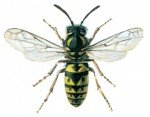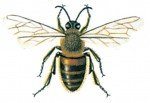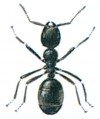
Bees, wasps and ants belong to the group of insects known as hymenoptera (Hymenoptera).

Many hymenoptera have sucking mouth parts, a tube with which they can drink liquid such as nectar. In addition, their mandibles are used to bite and chew, and for many of the hymenoptera, it is an important tool when they build their nests.
Most hymenoptera are good fliers. They have two pairs of relatively short and narrow, clear wings, and the hind wings are smaller than the fore wings.
Bees, wasps and ants have slender waists in the front of the abdomen. They have “wasp waists”. It allows the abdomen to move freely, and helps the animals when they sting.
With the exception of most ants and a few bees, most of the hymenoptera females have stings. It consists of three needle- or blade-shaped parts. In some species, it is exclusively used as an ovipositor during the oviposition. Most of the species can use the sting as defense or attack weapons, as some of the glands, which are related to the female reproductive organs, produce venom.

The larvae are usually pale, fat and legless and are fed by the adults.
Some hymenopteran have highly organized societies with division of labor between different types of individuals. One or more queens take care of the eggs. Practical labor is carried out by workers, which are actually females whose ovaries have not developed. The males’ only job is to mate with the young queens.
The social hymenoptera may also cooperate in defense. The individuals which are first aware of the danger, emit fragrances that alert the others and work them up so they will sting.




